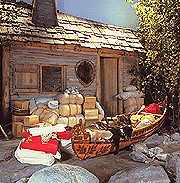Canada Hall
 The Fur Trade
The Fur Trade
During the French regime, the fur trade was the major commercial activity that sustained the colony. The French fur trade industry was a highly specialized enterprise. The chain of authority began with a French merchant who lived in France. He purchased and sold imported goods such as sugar, tobacco, and indigo dyes, as well as furs. The marchand-équipeur, or outfitter, living in New France was responsible for the North American end of the business. He purchased the necessary equipment for travelling into the hinterland, hired the crew, imported trade goods, and enticed local merchants into investing in the enterprise.
-
Powder Horn, Montreal, late eighteenth century
The map engraved on this powder horn shows the fur trading routes on both sides of the Canadian-American border.
The leader of the expedition was the marchand-voyageur, or travelling merchant, a licensed trader who did the actual buying and negotiating with the Native trappers. Next in line were the engagés, who worked as canoe paddlers, porters, and general labourers. Under the English regime, these men became known as voyageurs. Also included in the expedition was an interpreter, who helped merchants and Native people communicate with each other; and a commis, or clerk, who kept a record of all transactions concluded during the expedition. At the end of the line were the most notorious and least understood players in the game, the coureurs des bois (known under the British regime as "freemen"), who purchased furs without a legal permit. These traders, who integrated into the Native community and married Native women, were considered outlaws by colonial officials.
The eighteenth-century Upper Great Lakes voyageur camp featured in this section of the Hall is representative of those found throughout the country. It was in such a setting that Europeans and Native trappers exchanged furs for trade goods. In this particular scene, the trappers have arrived in their canot du Nord (small birchbark canoe) with bundles of furs. The furs have probably passed through many hands and travelled hundreds of kilometres before arriving at this rendez-vous point.


Trading has not yet begun; it was not discussed on the first day. Instead, food and tobacco were shared, gifts were exchanged, and everyone got caught up on the gossip. The real business started the next day. The major trade goods were woollen blankets, cotton and linen cloth, metal goods, firearms and fishing gear. Tobacco, alcohol, trade jewellery and other luxury items accounted for only ten percent of the goods traded.
The fur traders received far more than furs from Native people. They acquired valuable knowledge and skills for survival in the wilderness. This was particularly true of the coureurs des bois, who adopted Native ways, including the clothing, food, lodging, modes of transportation, languages, and customs.


